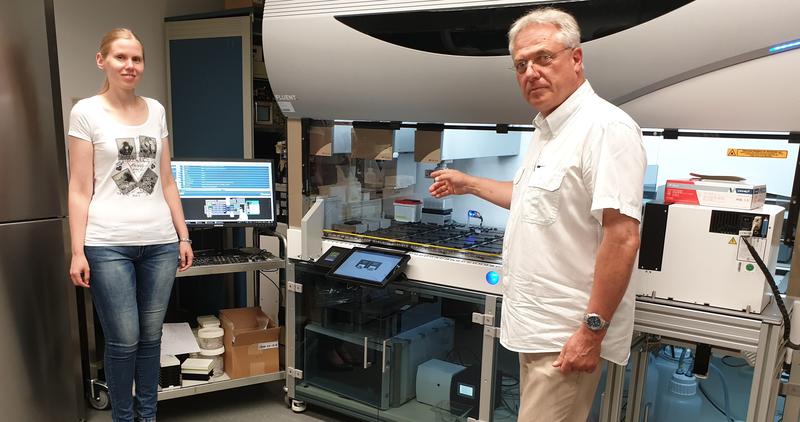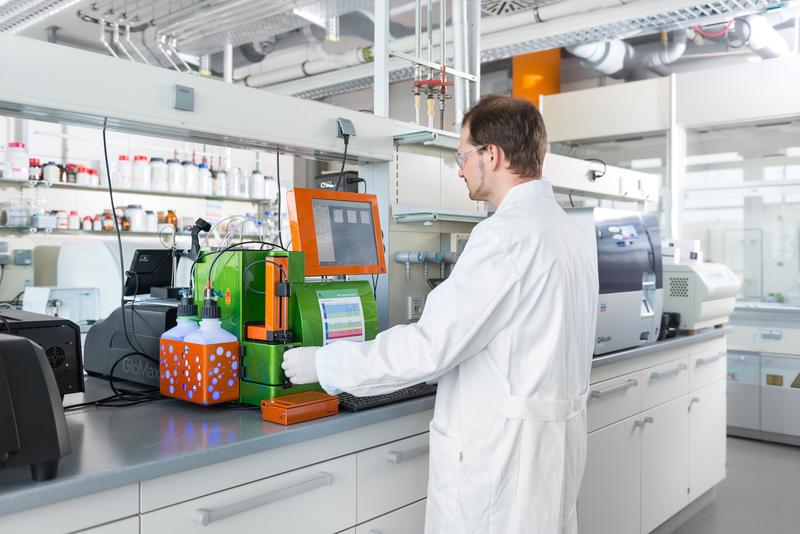Dr. Franziska Haag (l) and PD Dr. Dietmar Krautwurst in front of the high-throughput pipetting and measuring robot (TECAN Fluent®). They use the device to investigate the odorants to which human olfactory receptors react. G. Olias, Leibniz-LSB@TUM
Olfactory perception is crucial for the recognition and selection of food as well as for the enjoyment when eating. Everyone knows this at the latest when nothing tastes good anymore due to a blocked nose. The perception of odors also influences the behavior of many animals.
For 80 percent, the odor spectrum is unknown
The genes for the receptors with which we perceive odors have been known for over 30 years. However, despite intensive research, the specific odorant spectrum detected by about 80 percent of human olfactory receptors is still unknown.
New findings in this area could help to develop biobased "artificial noses" that can be used, for example, to monitor the sensory quality and authenticity of food. In addition, they could provide insight into the physiological functions of these receptors that go beyond the sensory perception of food.
"In particular, odorants such as pyrazines are interesting in this regard. This is because some of them, as key odorants, shape the typical aroma of food and, at the same time, play a major role as volatile signaling substances in olfactory communication of animals. A good example is wolves, which leave scent messages in their territory via their urine and thus mark it," says team leader Dietmar Krautwurst.
Pyrazine with a dual function
Trimethylpyrazine is one such substance. It is formed during roasting processes, and its scent is reminiscent of baked potatoes, roasted nuts and cocoa. It is therefore a frequently used flavoring agent in the food industry. Likewise, this substance is naturally present in the urine of foxes and wolves and puts mice on alert as soon as they smell it.
However, it was previously unknown which of the human olfactory receptors react to pyrazines. Therefore, the research team used a cellular assay system established at the institute to investigate the responses of over 600 human receptor variants to trimethylpyrazine. As the study results show, the odorant receptor OR5K1 was the only one of the tested variants to react to the substance. A check of the receptor with further odorants showed that it selectively recognizes 18 other pyrazines. For the test, the team used, among other volatiles, 178 key odorants that shape the aroma of food, including some pyrazines.
"Strikingly, those pyrazines, which activate the receptor most potently, function both as food odorants and signaling substances in the animal kingdom," reported Franziska Haag of the Leibniz Institute of Food Systems Biology at the Technical University of Munich, who, together with her former colleague Patrick Marcinek, played a key role in the study. As the study results also showed, corresponding (homologous) olfactory receptors of domestic and farm animals, but also of mice, responded in a similar way to the tested pyrazines as the human receptor. "We therefore assume that the recognition spectrum of the OR5K1 odorant receptor has evolved under the influence of domestication," explains Dietmar Krautwurst. Veronika Somoza, director of the Leibniz Institute adds, "In the future, we will use our unique, extensive odorant and receptor collection at the institute to decipher the function of human olfactory receptors."
Publication: Marcinek P, Haag F, Geithe C, Krautwurst D (2021) FASEB J, 35(6):e21638, DOI: 10.1096/fj.202100224R. An evolutionary conserved olfactory receptor for foodborne and semiochemical alkylpyrazines, Open Access, faseb.onlinelibrary.wiley.com/doi/10.1096/fj.202100224R
Expert contact:
PD Dr. Dietmar Krautwurst
Leibniz Institute for Food Systems Biology at the Technical University (Leibniz-LSB@TUM)
Lise-Meitner-Str. 34
85354 Freising, Germany
Phone: +49 8161 71-2634
Email: d.krautwurst.leibniz-lsb@tum.de
Dr. Franziska Haag
Leibniz-LSB@TUM
Phone: +49 8161 71-2716
Email: f.haag.leibniz-lsb@tum.de
Director of Leibniz-LSB@TUM:
Prof. Dr. Veronika Somoza
Email: v.somoza.leibniz-lsb@tum.de
Press contact:
Dr. Gisela Olias
Leibniz-LSB@TUM
Knowledge transfer, press and public relations work
Phone: +49 8161 71-2980
Email: g.olias.leibniz-lsb@tum.de
www.leibniz-lsb.de
Information about the Leibniz Institute
The Leibniz Institute for Food Systems Biology at the Technical University of Munich (Leibniz-LSB@TUM) has a unique research profile. Its researchers combine methods of basic biomolecular research with analytical methods of bioinformatics and analytical high-performance technologies. Their goal is to decode the complex ingredient profiles from raw materials to the final food products and to elucidate their function as biological active molecules on humans. Based on their studies, the scientists develop products, which are as healthy as they are tasty. These foods will help to provide a sustainable and sufficient stream of food for future generations. In addition, the new scientific findings will be used to develop personalized nutritional concepts that, for example, help people with food intolerance without compromising quality of life and endangering their health.
The Leibniz LSB@TUM is a member of the Leibniz Association, which connects 96 independent research institutions. Their orientation ranges from the natural sciences, engineering and environmental sciences through economics, spatial and social sciences to the humanities. Leibniz Institutes devote themselves to social, economic and ecological issues. They conduct knowledge-oriented and application-oriented research, also in the overlapping Leibniz research networks, are or maintain scientific infrastructures and offer research-based services. The Leibniz Association focuses on knowledge transfer, especially with the Leibniz Research Museums. It advises and informs politics, science, business and the public. Leibniz institutions maintain close cooperation with universities - among others, in the form of the Leibniz Science Campuses, industry and other partners in Germany and abroad. They are subject to a transparent and independent review process. Due to their national significance, the federal government and the federal states jointly fund the institutes of the Leibniz Association. The Leibniz Institutes employ around 20,000 people, including 10,000 scientists. The entire budget of all the institutes is more than 1.9 billion euros.
+++ Via our Twitter channel twitter.com/LeibnizLSB you stay up to date +++
Contact for scientific information:
PD Dr. Dietmar Krautwurst
Leibniz Institute for Food Systems Biology at the Technical University (Leibniz-LSB@TUM)
Lise-Meitner-Str. 34
85354 Freising, Germany
Phone: +49 8161 71-2634
Email: d.krautwurst.leibniz-lsb@tum.de
Dr. Franziska Haag
Leibniz-LSB@TUM
Phone: +49 8161 71-2716
Email: f.haag.leibniz-lsb@tum.de
Original publication:
Marcinek P, Haag F, Geithe C, Krautwurst D (2021) FASEB J, 35(6):e21638, DOI: 10.1096/fj.202100224R. An evolutionary conserved olfactory receptor for foodborne and semiochemical alkylpyrazines, Open Access, faseb.onlinelibrary.wiley.com/doi/10.1096/fj.202100224R





